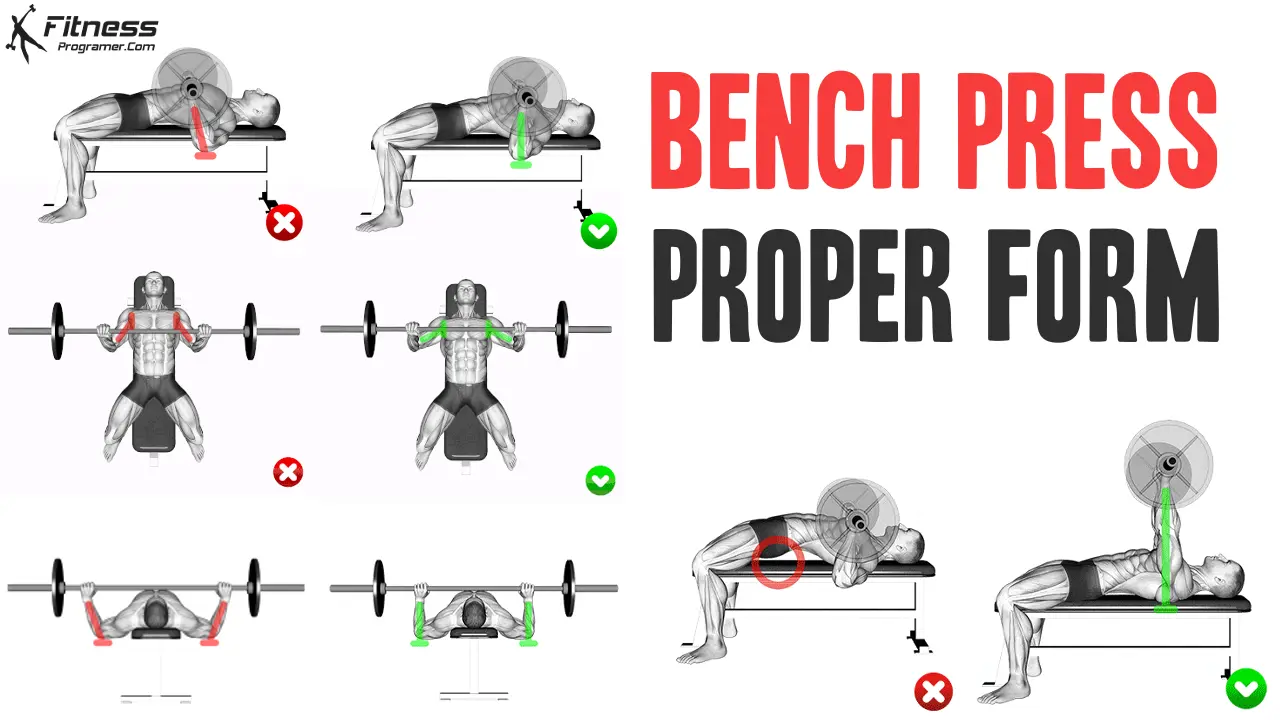Contents
The bench press is a compound exercise that primarily targets the pectoralis major (chest muscles). It also works the triceps, anterior deltoids (front shoulders), and stabilizer muscles. As a certified fitness coach, I’ve witnessed how mastering this exercise can transform workouts—when executed correctly.
Beyond aesthetics, a strong bench press improves functional strength and performance in sports requiring upper-body power, like football, basketball, or wrestling. However, improper form can lead to shoulder strain, wrist injuries, or uneven muscle development. Mastering proper technique ensures you build strength safely and effectively.
If you’re planning to create an effective strength training or chest workout plan, understanding how to bench press with proper form is essential. In this guide, I’ll walk you through the correct way to perform a bench press, share pro tips, and address common mistakes to help you get the most out of this essential exercise.
How to Bench Press with Proper Form
1. Set Up Properly
Proper setup is the foundation of a successful bench press.
- Position the Bench and Bar: Ensure the bench is stable, with the barbell positioned at a height that allows you to unrack it without excessive strain.
- Lie Down Correctly: Position your body so your eyes are directly under the bar. This alignment helps maintain a safe path of motion.
- Foot Placement: Plant your feet firmly on the ground, slightly behind your knees. Your heels should remain on the floor to provide a stable base.
- Back Position: Maintain a slight natural arch in your lower back, with your shoulder blades retracted and pressed into the bench.
- Engage Your Shoulders and Back: Retract your shoulder blades and press them firmly into the bench. This protects your shoulders and provides a strong pressing base.
2. Grip the Bar Correctly

Your grip plays a pivotal role in bench press performance and safety.
- Use a pronated grip (palms facing away) with thumbs wrapped securely around the bar.
- Place your hands slightly wider than shoulder-width apart. This alignment helps target the chest while minimizing shoulder strain.
- Ensure Symmetry: Check that your hands are evenly spaced using the markings on the barbell.
3. Unrack the Bar Safely

- Engage your core and brace your body as you lift the bar off the rack.
- Extend your arms fully and position the bar directly above your shoulders.
4. Lower the Bar with Control

- Inhale deeply and begin lowering the barbell.
- Keep your elbows at a 45 to 75-degree angle to your torso to minimize stress on your shoulders.
- Lower the bar until it lightly touches your chest, just below the nipple line. Avoid bouncing the bar off your chest.
5. Press the Bar Back Up
- Exhale forcefully and press the bar upward with controlled power.
- Focus on engaging your chest and triceps as you push.
- Fully extend your arms without locking out your elbows.

Common Mistakes and How to Avoid Them
1. Elbows Flaring Out Too Much:

Problem:
- When your elbows flare out excessively (close to 90 degrees), it shifts the focus from your chest to your shoulders and increases strain on the shoulder joints. Over time, this can lead to discomfort or injury, such as rotator cuff problems.
Fix:
- Visualize keeping your elbows tucked slightly closer to your body, aiming for a 45 to 75-degree angle relative to your torso.
- If you’re unsure of your positioning, practice with a lighter weight or use a mirror to monitor your elbow angle.
- Cue yourself to “bend the bar” outward, which naturally helps keep your elbows in the correct position.
2. Improper bar path:

Problem:
- A proper bar path allows you to lift more weight by maintaining an efficient transfer of force. Keeping the bar on the correct path minimizes the risk of shoulder impingement or strain.
Fix:
- Lower the bar in a straight line down toward your mid-to-lower chest. Avoid drifting too far forward (toward your head) or backward (toward your abdomen).
3. Retract Your Shoulder Blades:

Problem:
- Neglecting to retract and stabilize your shoulder blades during the bench press reduces shoulder support and limits chest activation. This instability can lead to improper lifting mechanics.
Fix:
- Before unracking the bar, actively pull your shoulder blades together as if pinching a pencil between them.
- Once retracted, press your shoulder blades firmly into the bench. This creates a stable base and maximizes chest engagement.
- Keep this scapular position maintained throughout the lift; avoid letting your shoulders roll forward at the top of the press.
4. Maintain a Neutral Spine

Problem:
- While a slight arch in your lower back is normal and safe, excessive arching (or “overarching”) can strain your lumbar spine and shift the focus away from your chest.
fix:
- Keep a natural arch in your lower back that allows your torso to stay firm but your hips to remain on the bench.
- Avoid lifting your buttocks off the bench, as this compromises your form and increases lower back stress.
- Tighten your core muscles to stabilize your torso. Think of bracing your core as if preparing for a punch.
5. Improper Grip Width:

Problem:
A narrow grip overemphasizes the triceps and reduces chest activation, while a wide grip puts undue strain on your shoulder joints and increases the risk of injury.
Fix:
- Use a grip that positions your hands slightly wider than shoulder-width apart.
- At the bottom of the movement, your forearms should be perpendicular to the floor.
- Avoid letting your wrists collapse backward by keeping them neutral and directly under the bar.
Why Trust My Expertise?
As a certified fitness coach, I’ve helped individuals of all levels—from beginners to seasoned lifters—perfect their bench press technique. My approach combines years of hands-on experience with evidence-based training principles, ensuring clients achieve their goals safely and efficiently.
Final Thoughts
The bench press is a powerhouse exercise that deserves a spot in any well-rounded training program. By mastering the correct form, you’ll unlock its full potential to build strength, muscle mass, and functional power. Start with manageable weights, prioritize technique, and increase the load gradually as your confidence and strength improve.
If you’re unsure about your form or looking to enhance your routine, don’t hesitate to consult a qualified trainer for guidance. Remember, every great lift starts with great form.



